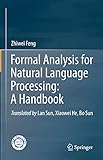Formal Analysis for Natural Language Processing: A Handbook [electronic resource] /
Material type: TextPublisher: Singapore : Springer Nature Singapore : Imprint: Springer, 2023Edition: 1st ed. 2023Description: XVII, 796 p. 3 illus. in color. online resourceContent type:
TextPublisher: Singapore : Springer Nature Singapore : Imprint: Springer, 2023Edition: 1st ed. 2023Description: XVII, 796 p. 3 illus. in color. online resourceContent type: - text
- computer
- online resource
- 9789811651724
- 006.35 23
- QA76.9.N38
Preface -- Chapter 1. Past and Present of Natural Language Processing -- Chapter 2. Pioneers in Study of Language Computing -- Chapter 3.Formal Models Based on Phrase Structure Grammar -- Chapter 4.The Formal Model Based on Unification -- Chapter 5.Formal Models Based on Dependency and Valence -- Chapter 6.Formal models based on lexicalism -- Chapter 7. Formal Models of Automatic Semantic Processing -- Chapter 8. Formal Models of Automatic Situation and Pragmatic Processing -- Chapter 9. Formal Models of Discourse Analysis -- Chapter 10.Formal Models of Probabilistic Grammar -- Chapter 11. Formal Models Based on Neural Networks and Deep learning -- Chapter 12. Knowledge Graphs -- Conclusion.
The field of natural language processing (NLP) is one of the most important and useful application areas of artificial intelligence. NLP is now rapidly evolving, as new methods and toolsets converge with an ever-expanding wealth of available data. This state-of-the-art handbook addresses all aspects of formal analysis for natural language processing. Following a review of the field’s history, it systematically introduces readers to the rule-based model, statistical model, neural network model, and pre-training model in natural language processing. At a time characterized by the steady and vigorous growth of natural language processing, this handbook provides a highly accessible introduction and much-needed reference guide to both the theory and method of NLP. It can be used for individual study, as the textbook for courses on natural language processing or computational linguistics, or as a supplement to courses on artificial intelligence, and offers a valuable asset for researchers, practitioners, lecturers, graduate and undergraduate students alike.


There are no comments on this title.